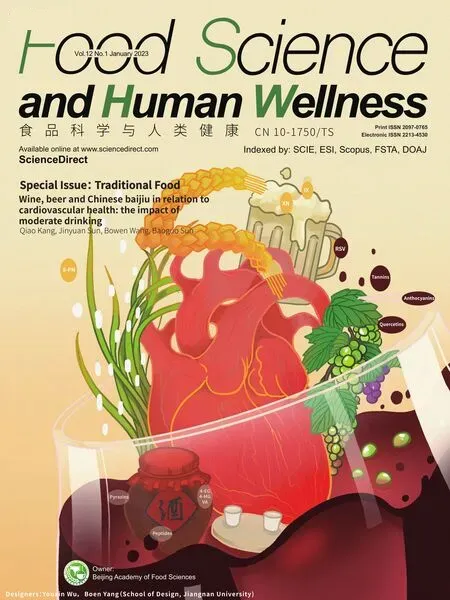Characterization and comparison of the aroma-active compounds on different grades of sesame-f lavor Baijiu by headspace solid-phase microextraction and gas chromatography-olfactometry-mass spectrometry
2023-01-22DnQinJiwenDunHeheLibFupingZhengbHunChengXingqinYeBoguoSunb
Dn Qin, Jiwen Dun, Hehe Lib,,*, Fuping Zhengb,, Hun Cheng,Xingqin Ye,*, Boguo Sunb,
a College of Biosystems Engineering and Food Science, Zhejiang Key Laboratory for Agro-food Processing, Fuli Institute of Food Science, Zhejiang University, Hangzhou 310058, China
b Beijing Laboratory for Food Quality and Safety, Beijing Technology and Business University, Beijing 100048, China
c Key Laboratory of Brewing Molecular Engineering of China Light Industry, Beijing Technology and Business University, Beijing 100048, China
Keywords:Sesame-flavor Baijiu Baijiu grades Sensory evaluation Principal component analysis 2-Furylmethanethiol
A B S T R A C T This study investigated the aroma-active compounds and compared the differences of three different grades of sesame-flavor Baijiu by headspace solid-phase microextraction (HS-SPME) coupled with gas chromatography-olfactometry-mass spectrometry (GC-O-MS). A total of 54 aroma-active compounds were detected. Principal component analysis showed that JZ1, JZ2, and JZ3 were well separated from each other.JZ1 as the premium-grade Baijiu had the highest aroma intensities, concentrations. According to aroma intensities and concentrations, dimethyl trisulfide, butanoic acid, phenylacetaldehyde, 2-furylmethanethiol,ethyl hexanoate, 2,6-dimethylpyrazine, etc. could be potentially applied as volatile makers to distinguish the three different grades of sesame-f lavor Baijiu as their signif icant difference (P < 0.05) in three Baijiu samples.Roasted aroma had the signif icant difference (P < 0.05) in three sample base on aroma prof iles. Meanwhile,2-furylmethanethiol, 2,6-dimethylpyrazine were related to the roasted aroma, they may be had a signif icant contribution to the differences of three different grades of sesame-f lavor Baijiu. This study has provided a comprehensive understanding of the differences of three different grades of sesame-f lavor Baijiu.
1. Introduction
Baijiu is a traditional distilled spirit with a history of more than 2 000 years in China. Compared with other distilled spirits, Baijiu normally has a higher alcohol content round 40% to 65% [1]. The production of Baijiu in 2019 was 7.86 million kiloliters (data from the China Industry Information Network) [2]. The popularity of Baijiu in China makes it the world’s most consumed spirit with gaining popularity outside of China too [3]. Baijiu is mainly made using grain as raw material, Jiuqu as saccharification fermentation starter [4].Solid-state fermentation and Zeng distillation [5] are used to produce base Baijiu, which is then aged and blended to prepare the commercial product. The production processing of Baijiu is unique in the world.
Baijiu is mainly composed of ethanol and water, which account for 98% of the total weight, and the remaining 2% are trace components. Notably, research has shown that these trace compounds have significant contributions to the flavor of Baijiu [6-8].Until now, more than 1 870 [5] volatile compounds have been reported in Baijiu, which includes esters, acids, alcohols, sulfurcontaining, aldehydes compounds, etc. Gas chromatographymass spectrometry (GC-MS) coupled with gas chromatographyolfactometry (GC-O) is a valuable tool to conf irm the presence of aroma-active compounds [9,10].
Baijiu can be classified into 12 categories [5,11] based on aroma characteristics, which include light, strong, soy sauce, complex,sesame, rice, etc. Among them, sesame-flavor Baijiu has the pure and elegant flavor of the light aroma-type Baijiu, the softness and fullness of the strong aroma-type Baijiu, the elegant and delicate flavor of the soy sauce aroma-type Baijiu, and overall has a unique roasted sesame-like flavor, which is very popular in northern China [12].Sesame-flavor Baijiu is mainly produced in Shandong province of China, and some of the famous brands, such as Jingzhi, Guojing,Yanghu, and Baotuquan are produced in this region. Among these brands of the sesame-flavor Baijiu, the research about Jingzhi has attracted significant attention over the recent years, with Jingzhi being considered the most representative sample of sesame-flavor Baijiu.Zheng et al. [13] used liquid-liquid extraction (LLE) coupled with GC-MS and GC-O to characterize the key odorants in Jingzhi. The experiment confirmed the importance of the contribution of methional and ethyl hexanoate to the overall aroma of Jingzhi. Sha et al. [14] used HS-SPME coupled with GC-MS and GC-O to characterize the key odorants of Jingzhi and 2-furfurylthiol, dimethyl trisulfide, methional,andβ-damascenone were considered as the great contribution to the unique sesame-flavor of Jingzhi Baijiu. Chen et al. [15]reported 340 volatile compounds in Jingzhi by HS-SPME comprehensive two-dimensional gas chromatography/time-of-flight mass spectrometry (GC × GC-TOF MS).
Most of the studies in this direction have thus far focused on the volatile compounds or characteristic aroma compounds, and studies focused on the differences between the various grades of the sesameflavor Baijiu have been limited. Therefore, the objectives of this study were to investigate the aroma-active compounds in different grades of sesame-flavor Baijiu by HS-SPME-GC-O-MS, compare their sensory contribution, and find the differences between the three different grades of the sesame-flavor Baijiu. This study could contribute to the improvement of the aroma and quality of sesame-flavor Baijiu.
2. Materials and methods
2.1 Samples
Three Jingzhi sesame-flavor commercial Baijiu (labeled as JZ1,JZ2, and JZ3, 53% ethanol by volume) were selected. The three Baijiu samples were acquired from China Alcoholic Drinks Association and manufactured in the Shandong province, China. The representative of the three Baijiu samples were confirmed by national professional Baijiu tasting judges, who considered JZ1 as premium grade Baijiu(the sesame aroma is obvious, the sourness and chen-aroma (the aging process makes the Baijiu naturally form the mature aroma characteristics) [16] are outstanding; it is sour and mellow in the mouth,the aftertaste is long, and the style is typical), JZ2 as first grade Baijiu(with sesame aroma, comfortable in the mouth, and the Baijiu body is harmonious), and JZ3 as secondary grade Baijiu (sesame aroma is weak,the Baijiu body is thin, and the aftertaste is light). All Baijiu samples(500 mL, respectively) were stored at 4 °C refrigerator until analysis.
2.2 Chemicals
The following chemical standards (GC grade, ≥ 97% purity)were used. 2-Methylpropanal, 3-methylbutanal, acetaldehyde diethyl acetal, furfural, phenylacetaldehyde, ethyl acetate, ethyl propanoate,ethyl butanoate, ethyl 3-phenylpropanoate, ethyl 2-methylpropanoate,ethyl hexadecanoate, ethyl pentanoate, ethyl 2-methylbutanoate,ethyl 3-methylbutanoate, ethyl lactate, ethyl nonanoate, ethyl hexanoate, ethyl octanoate, propyl hexanoate, 2-phenylethyl acetate,diethyl butanedioate, ethyl 4-methylpentanoate, ethyl phenylacetate,2-methylpropanol, 2-methyl-1-butanol, 2-furanmethanol, butanol,hexanol, 3-methyl-1-butanol, 2-phenylethanol, acetic acid,3-methylbutanoic acid, hexanoic acid, butanoic acid, pentanoic acid,octanoic acid, nonanoic acid,γ-nonalactone, 2,6-dimethylpyrazine,2-ethyl-6-methylpyrazine, dimethyl trisulfide, methional,2-furylmethanethiol, benzenemethanethiol, 4-ethylguaiacol,p-cresol,and were purchased from Sigma-Aldrich (Shanghai, China). Internal standards (IS) including 4-octanol (IS1), diethylacetic acid (IS2), and pentyl acetate (IS3) were purchased from Sigma-Aldrich (Shanghai,China). A C7−C40n-alkane mixture (Sigma-Aldrich, Shanghai, China)was used to calculate retention indices (RI). Absolute ethanol (HPLC)and sodium chloride (NaCl) were obtained from China National Pharmaceutical Group Corp. (Shanghai, China).
2.3 Aroma extraction by headspace solid-phase microextraction
The method reported by Li et al. [17] was employed with slight modifications. Baijiu samples (53% ethanol by volume) were diluted to 10% ethanol (V/V). Then, diluted samples (8 mL) and 3 g of NaCl were put in 20 mL headspace injection vials. Magnets were added to the headspace vials for agitation, and the vials were sealed with corks.The vials were then placed in 40 °C water bath and equilibrated for 15 min. The 50/30 μm divinybenzene/carboxen/ polydimethy-lsiloxane(DVB/CAR/PDMS) three-phase extraction head was selected and inserted into the headspace vial, and extraction was carried out for 40 min. The extraction head was then pulled out and desorbed at the front injection port (250 °C) of the GC-O-MS for 5 min.
2.4 Identification of aroma-active compounds by GC-O-MS
GC-O-MS analyses were operated on an Agilent 7890B gas chromatograph, equipped with an Agilent 5977A mass selective detector (MSD) and a sniff port (ODP3, Gerstel, Germany). All Jingzhi samples were analyzed on a DB-WAX column (60 m × 0.25 mm i.d.,0.25 μm film thickness, J&W Scientific, USA) and an HP-5MS column (30 m × 0.25 mm i.d., 0.25 μm film thickness, J&W Scientific, USA). Helium was used as the carrier gas with a constant flow rate of 1.0 mL/min. The oven temperature was initially at 40 °C,then increased to 50 °C (held for 5 min) at the rate of 10 °C/min,then ramped to 80 °C (5 min) at 3 °C/min, finally increased to 230 °C(10 min) at 5 °C/min.
The column flow was split (1:1) to ODP3 and MSD at the end of the capillary. The temperature of the olfactory port was 250 °C. The electron ionization energy of the mass spectra was 70 eV, and the temperature of ion source was 230 °C. The range of masses full-scan was used in the 35−350 amu. GC-O was employed by two trained panelists (one male and one female, with an average age of 26)from the Laboratory of Baijiu Chemistry at Beijing Technology and Business University. During the sample running on GC, a panelist placed his/her nose close to the sniffing port, meanwhile,recorded the retention time, aroma descriptors and intensity value.Aroma intensities of the compounds were ranked on a five-point scale (0, 1, 2, 3, 4) with 0 representing a not perceivable aroma, 1 representing a weak aroma, 2 representing a slightly stronger aroma,3 representing a significant aroma, and 4 representing a strong aroma. Sample was analyzed by two trained panelists and repeated in triplicate by each panelist on each column. Aroma compounds was confirmed by comparison of their mass spectra, odors, and RI with the corresponding pure standards. The RI values were calculated by the C7–C40n-alkane mixture.
2.5 Quantitative analysis of aroma compounds
2.5.1 Quantitative analysis of aroma compounds by direct injection with GC-MS
Using the method of Zhang [18] with slight modifications, 2 mL each of the Baijiu sample was placed in respective 10 mL centrifuge tube, and 40 μL of the mixed internal standards (IS1, IS2, and IS3,final concentration was 20 mg/L, respectively) were added. After shaking and mixing evenly, anhydrous sodium sulfate was added, and the mixture was shaken well and stand for 5 min until the solid in the centrifuge tube had a quicksand state. The centrifuge tube was sealed with parafilm and placed in a refrigerator at -20 °C overnight. The liquid sample was filtered using a 0.22 μm organic film, and 1 μL of the sample was used for GC-MS analysis.
The ratio of the peak area of the volatile compound in the Baijiu sample to that of the internal standard and the concentration of the internal standard were used to calculate the concentration of the target compound in the Baijiu sample. 4-octanol (IS1, 20 mg/L final concentration) was used as the internal standard for the alcohol compounds in the Baijiu sample, diethylacetic acid (IS2, 20 mg/L final concentration) for the acidic compounds, and pentyl acetate (IS3,20 mg/L final concentration) for the esters compounds and others.
GC-MS analyses were performed on an Agilent 7890B GC and Agilent 5977A MSD with a DB-FFAP column (60 m × 0.25 mm i.d.,0.25 μm film thickness, J&W Scientific, USA). The oven temperature was initially at 40 °C, then increased to 50 °C (held for 10 min) at the rate of 10 °C/min, then ramped to 80 °C (10 min) at 3 °C/min, finally increased to 230 °C (2 min) at 5 °C/min. The other conditions were same with GC-O-MS.
2.5.2 Quantitative analysis of 2-furylmethanethiol by LLE with GC×GC-SCD
LLE coupled with comprehensive two-dimensional gas chromatography-sulfur chemiluminescence detector (GC × GCSCD) were used to quantify 2-furylmethanethiol. Using the method of Song et al. [19], Jingzhi sesame-flavor Baijiu sample (25 mL)was diluted to an ethanol content of 10% (V/V) by Milli-Q water and NaCl was added to saturation. The sample was extracted three times with 30 mL of dichloromethane each time. The combined extracts were dried using anhydrous sodium sulfate and then concentrated to 0.5 mL by Vigreux column. A stock solution of 2-furylmethanethiol was obtained by dissolving the pure standard of the compound in 53%(V/V) aqueous ethanol and then diluting it to five different gradients of concentrations. They were extracted according to the method of Baijiu sample. The standard curve was made by plotting the peak area of the standard compound to the concentration.
GC × GC-SCD analysis (LECO, Saint Joseph, MI, USA) was performed on an Agilent 7890B GC (Agilent Corp., USA) equipped with a dual-stage-four jet modulator and a SCD 355 detector (Agilent Corp., USA) [19]. A DB-WAX column (30 m × 0.25 mm, 0.25 μm,Agilent, USA) and a DB-5 column (2 m × 0.1 mm, 0.1 μm, Agilent,USA) were used as the first- and second-dimensional columns,respectively. The carrier gas was helium with a flow of 1 mL/min.1 μL of the concentrated sample was injected in splitless mode. The oven temperature was started at 50 °C, held for 2 min and then heated to 150 °C at 3 °C/min, finally heated to 230 °C at 5 °C/min, held for 10 min. The temperatures of the 355 SCD was 250 °C and the dual plasma controller was 800 °C. Hydrogen (flow rate 40 mL/min)and air (flow rate 60 mL/min) were used as the reaction gas. The acquisition rate for SCD was 50 Hz. The compound was confirmed by retention time of first- and second dimensional with the pure standard.
2.6 Descriptive profile tests
Sensory analyses were performed in a sensory panel room at(20 ± 1) °C by 10 trained panelists. The panelists (five males and five females, with an average age of 26) had been trained with wine nose (Le Nez Du Vin, including 54 compounds) and standards. After trained, 30 mL each of JZ1, JZ2, and JZ3 were placed in special Baijiu tasting glasses, respectively. Then the Baijiu samples were perceived by smelling and discussed by all panelists, 8 aroma terms were confirmed, and their responding references were as follows:acid, fruity, alcoholic, sulfur, roasted, grain, sweet, and floral notes.Then, the panelists were trained with 8 aroma terms and their responding references (acetic acid for acid note, ethyl hexanoate for fruity note, ethanol for alcoholic note, dimethyl trisulfide for sulfur note,roasted sesame seed for roasted note, steamed sorghum for grain note,γ-nonalactone for a sweet note, and ethyl 3-phenylpropanoate for floral note) and asked to score the intensities of 8 aroma attributes on a six-point scale (0, 1, 2, 3, 4, 5) with 0 representing not perceivable, 1 representing weak, 3 representing significant, and 5 representing strong.
2.7 Statistical analysis
Principal component analysis (PCA) was employed to extract the first and second principal components from the data of the aroma compounds and categorize the differences between the different grades of the sesame-flavor Baijiu using XLSTAT 2016 (Addinsoft,New York, NY, USA). Data from the aroma intensities and concentrations and descriptive analysis were evaluated by analysis of variance (ANOVA) using SPSS v16.0 (SPSS Inc., Chicago, USA).
3. Results and discussion
3.1 Identification of aroma compounds in three different grades sesame-flavor Baijiu
A total of 61 aroma-active areas were identified by HS-SPME coupled with GC-O-MS analysis in three different grades of sesameflavor Baijiu, as shown in Table 1. The total ion chromatograph (TIC)of JZ2 as the representative, and the aroma intensity comparison of the three different grades of sesame-flavor Baijiu are shown in Fig. 1.There were 59, 58, 59 aroma-active areas in JZ1, JZ2, and JZ3 respectively. The aroma intensities of the different grades of sesameflavor Baijiu exhibited differences. Fig. 1 presents the intensities data, and JZ1, the premium-grade Baijiu, had relatively higher aroma intensity values, followed by JZ2 (first-grade Baijiu) and JZ3(secondary grade Baijiu). To further confirm the compounds, their mass spectra were compared with NIST 17 (Agilent Technologies,Inc.) and Baijiu in-house database. RIs and aroma attributes were compared with authentic standards. There were 54 aroma-active compounds were further confirmed by aroma, RI and standards. The aroma intensity of aroma-active compounds ranged from 1 to 4.
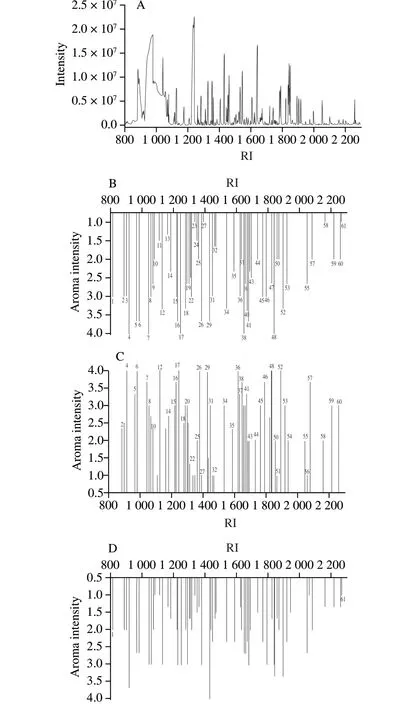
Fig. 1 The total ion chromatograph (TIC) of JZ2 and aroma intensity comparison of three different grades sesame-flavor Baijiu. (A,B) JZ2; (C) JZ1; (D) JZ3.
Generally, the compounds with higher aroma intensity make important contributions to the overall aroma of the respective Baijiu samples. Therefore, 2-furylmethanethiol (roasted sesame), dimethyl trisulfide (sulfur and cabbage-like), ethyl 2-methylpropanoate (fruity),ethyl pentanoate (apple), ethyl 3-phenylpropanoate (floral), ethyl hexanoate (fruity), 3-methylbutanal (malty),β-damascenone (honey),butanoic acid (rancid), and hexanoic acid (sweaty, rancid) make significant contributions to the aroma of JZ1 as their highest aroma intensity 4. Ethyl butanoate (pineapple), ethyl hexanoate (fruity),phenylacetaldehyde (grass), 3-methylbutanal (malty),β-damascenone(honey), and hexanoic acid (sweaty, rancid) have significant contributions to the aroma of JZ2 as their highest aroma intensity 4.2-Furylmethanethiol (roasted sesame) has a significant contribution to the aroma of JZ3 as their highest aroma intensity 4. Among these compounds have been reported as important odorants in whiskey [20], strong [21],light [22,23], soy sauce [24] and other aroma-type Baijiu [25,26].By comparison, JZ1 had the largest numbers of compounds with aroma intensity 4, dimethyl trisulfide, ethyl 2-methylpropanoate,ethyl pentanoate, ethyl 3-phenylpropanoate, butanoic acid had the highest aroma intensity only in JZ1. 2-Furylmethanethiol and dimethyl trisulfide were confirmed as important odorants in sesame-flavor Baijiu [11,13,14,27], the results were consistent with previous findings. Methional and benzenemethanethiol has been reported to have an important aroma contribution to sesame-flavor Baijiu [11,13,14,27], however they had the relative low aroma intensity in this paper, may be this is related to the adsorption selectivity and saturation of SPME head.
3.2 Quantification of aroma compounds in three different grades sesame-flavor Baijiu
3.2.1 Quantification of aroma compounds by direct injection
Volatile compounds were quantified using the direct injection(DI) with addition of anhydrous sodium sulfate in the three different grades of sesame-flavor Baijiu. The results presented in Table 2 clearly show that the concentrations of the esters were the highest,followed by those of acids and alcohols, in the three different grades of sesame-flavor Baijiu. Two pyrazines were quantified in this study,which were 2,6-dimethylpyrazine (1 071-1 625 μg/L) and 2-ethyl-6-methylpyrazine (328-442 μg/L). Some researchers presumed that pyrazines [28,29] could be the most important aroma compounds in sesame-flavor Baijiu.
To visually compare the differences in the levels of the volatile compounds, the histogram of their concentrations in the three different grades of sesame-flavor Baijiu is shown in Fig. 2 and Supplementary materials Fig. 1. Among esters, 16 esters including ethyl butanoate,ethyl hexanoate, ethyl pentanoate, ethyl 3-phenylpropanoate,isopentyl hexanoate, propyl hexanoate, et al. (as shown in Fig. 2) had the highest concentrations in JZ1, followed in JZ2, and had the lowest concentrations in JZ3. Esters were also one of the most important aroma groups for the other aroma types of Baijiu [30-33]. Most esters compounds had the highest concentrations in JZ1, while ethyl acetate and ethyl lactate are known to be important constituents in Baijiu samples, and had a relatively high concentration in JZ3, the secondary grade Baijiu, whereas had a relatively low concentration in JZ1, the premium-grade Baijiu, which indicates that the concentration of the compounds is not the only factor to determine the grade of Baijiu,and the overall interplay between the various compounds and food matrices should be paid more attention to understand their influence on the aroma of the Baijiu [34]. Among alcohols, 6 alcoholics including 2-methylpropanol, butanol, 2-phenylethanol, pentanol,hexanol, and benzenemethanol, had the highest concentrations in JZ1,while 3-methyl-1-butanol was present in the highest concentration in JZ2, whereas propanol, 2,3-butanediol, and propylene glycol(as shown in Supplementary materials Fig. 1) had the highest concentrations in JZ3. Seven acids including butanoic acid,3-methylbutanoic acid, pentanoic acid, hexanoic acid, heptanoic acid, octanoic acid, et al. had the highest concentrations in JZ1. In contrast, acetic acid, decanoic acid had the highest concentrations in JZ3. Among the other compounds, furfural, benzaldehyde,2,6-dimethylpyrazine, 2-furancarboxylicacid, 2-ethyl-6-methylpyrazine, andp-cresol had the highest concentrations in JZ1, while ethyl 2-furancarboxylate had the highest concentration in JZ2. Furfuryl alcohol and hexaldehyde diethyl acetal (as shown in Fig. S1) had the highest concentrations in JZ3. Statistical analysis showed ethyl butanoate, ethyl pentanoate, ethyl hexanoate, hexanol, butyric acid, pentanoic acid, hexanoic acid,2,6-dimethylpyrazine, furfural, ethyl 2-furancarboxylate etc. had significant difference (P< 0.05), they may be play an important role in differentiating the differences between three samples.
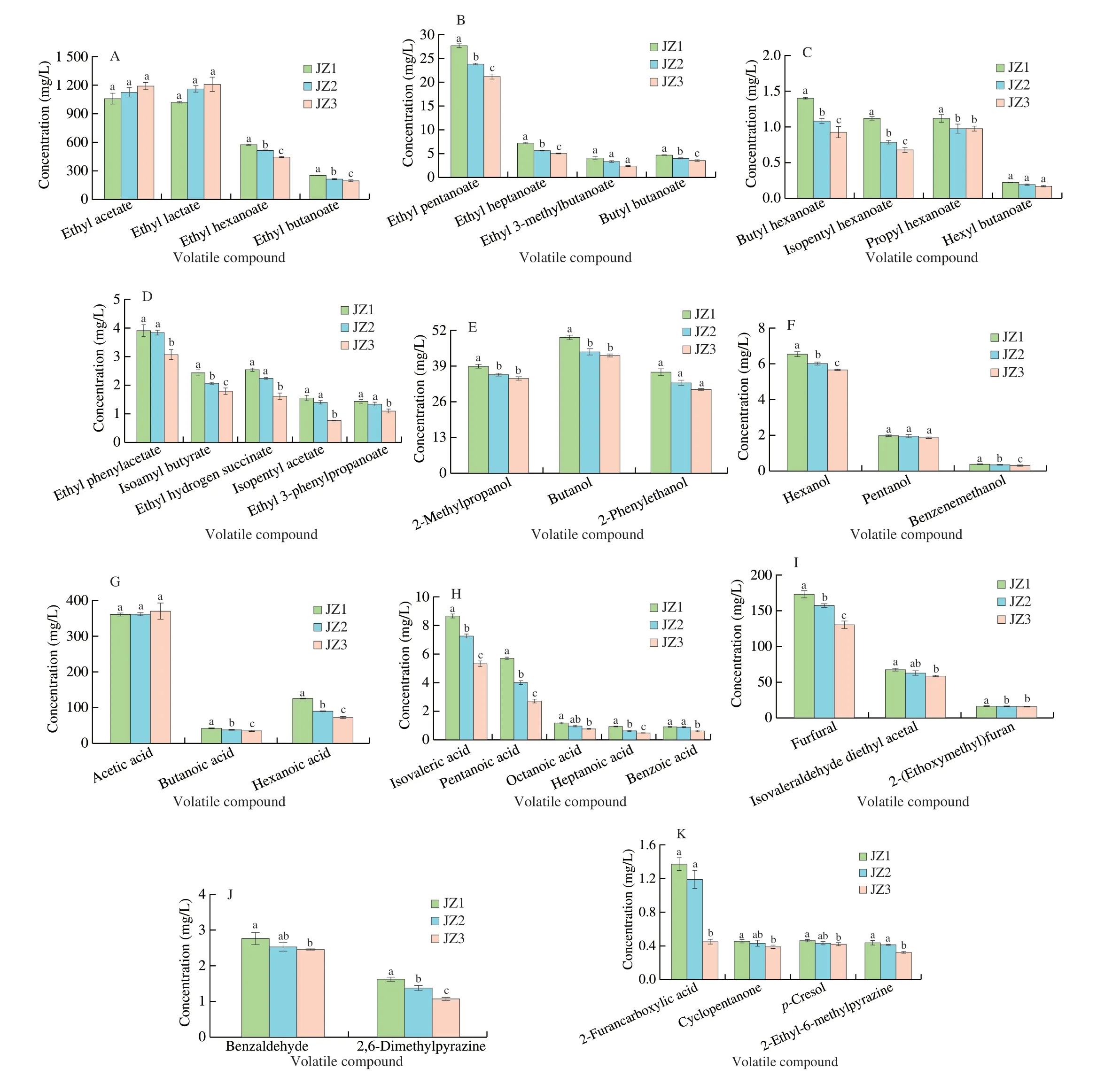
Fig. 2 Concentrations of main volatile compounds in three different grades sesame-flavor Baijiu. (A-D) Selected esters, (E-F) alcohols, (G-H) acids, (I-K)pyrazines, furans and others.
PCA is a type of multivariate statistical analysis method. As shown in Fig. 3 (PCA plot and loading), PCA plot based on the quantified data, the first principal component (PC1) and the second principal component (PC2) were taken as coordinate axes for the PCA analysis on different grades of sesame-flavor Baijiu, and the linear combination of PC1 and PC2 explained 83.04% of the total variance exhibited in the Baijiu samples. PC1 led to the separation of JZ1 and JZ3 because JZ1 were grouped on the positive side of PC1, whereas JZ3 was located on the negative side. On the other hand, PC2 contributed to the differentiation of JZ2 with JZ1 and JZ3.The factor loadings on the first two principal components are shown in Supplementary materials Table 1. Generally, the factor loadings with higher values are deemed important [35]. The variables which presented the highest loading absolute value (more than 0.98) on the principal component 1 were 3-methylbutanoic acid, pentanoic acid,hexanoic acid, ethyl butanoate, ethyl pentanoate, ethyl hexanoate,and 2,6-dimethylpyrazine, whereas for principal component 2, ethyl 2-furancarboxylate (0.913) and 3-methyl-1-butanol (0.838) were the most significant. The loading values further showed that these compounds were correlated most strongly with the aroma of the sesame-flavor Baijiu.

Fig. 3 Scores plot and loading of PCA based on aroma components. (A) PCA score plot, (B) loading plot.
3.2.2 Quantification of 2-furylmethanethiol by GC×GC-SCD
2-Furylmethanethiol (roasted sesame) had a significant contribution to the aroma of three samples (aroma intensity ≥ 3.7).Although the MS of 2-furylmethanethiol was not identified through HS-SPME, we alter the method of extraction to quantify 2-furylmethanethiol due to the high aroma intensity of this compound.Therefore, LLE coupled with GC × GC-SCD were used to quantify 2-furylmethanethiol. Firstly, 2-furylmethanethiol was accurately identified by comparing the first- and second- dimensional retention times (1 635, 2.36 s) of the target compound in the Baijiu sample with the corresponding pure standard retention times (1 645, 2.37 s). Then the standard curve was made by plotting the peak area of the standard compound to the concentration, the concentration gradients were 1,10, 50, 100, 300 μg/L respectively. The LOD of 2-furylmethanethiol was 0.12 μg/L, the obtained calibration curvesy= 3 × 107x- 4 × 108withR2= 0.991 1 had good linearity. The concentration of JZ1 was(22.43 ± 0.83) μg/L, JZ2 was (18.88 ± 0.20) μg/L, JZ3 was(16.29 ± 0.07) μg/L. SPSS statistical analysis showed that the concentration of 2-furylmethanethiol was significantly different(P< 0.05) among the three samples. The odor threshold of 2-furylmethanethiol was 0.1 μg/L [14], the OAVs of 2-furylmethanethiol in three Baijiu samples were all > 100, it was further indicated that the compound had an important contribution to the overall aroma of sesame flavor Baijiu.
3.3 Sensory analysis
The terms of roasted, alcoholic, acidic, sweet, fruity, grain, floral,and sulfur were used to describe the aroma of sesame-flavor Baijiu.And the eight attributes seemed to explain the aroma characteristics of the sesame-flavor Baijiu samples. Statistical analysis showed roasted had the significant difference (P< 0.05) in three sample,others did not show significant difference (P> 0.05). The ratio of intensities between different attributes may be responsible for the differences in Baijiu samples. As shown in Fig. 4, JZ1 had the highest roasted, fruity and sweet aroma than JZ2 and JZ3, as with most esters,which had the relatively highest aroma intensity values (Table 1)and concentrations in the quantified results of volatile compounds(Table 2) in JZ1. JZ3 presented the highest grain, acidic, and sulfur aromas, while roasted, fruity, sweet, floral, and alcoholic showed the lowest scores. The concentrations of most esters and alcoholics were lowest compared to the other two sesame-flavor Baijiu samples, may be this is the reason that JZ3 had the lowest intensities of fruity, floral and alcoholic notes. Meanwhile, the aroma of the acid compounds covered the other notes, as shown in Table 2, decanoic acid in JZ3 was at the highest concentration compared to that in JZ1 and JZ2.JZ2 showed the highest score in floral notes, the lowest score in acidic and sulfur than in JZ1 and JZ3. The outstanding level of floral in JZ2 was in agreement with the levels of some esters that had the relatively highest aroma intensity values (Table 1). Overall,different grades of the sesame-flavor Baijiu had differences in aroma profiles. Among these, JZ1 had the outstanding roasted aroma, and maybe, this is the key reason for JZ1 being the premium-grade Baijiu. Because, the typical characteristic of sesame-flavor Baijiu is its strong sesame aroma.
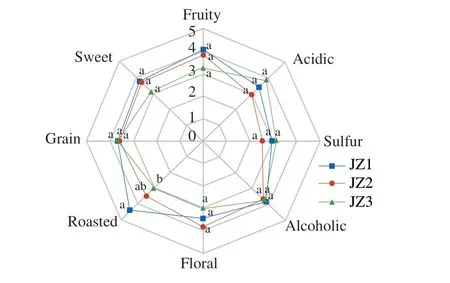
Fig. 4 Aroma profile of the mean sensory scores of three different grades sesame-flavor Baijiu.
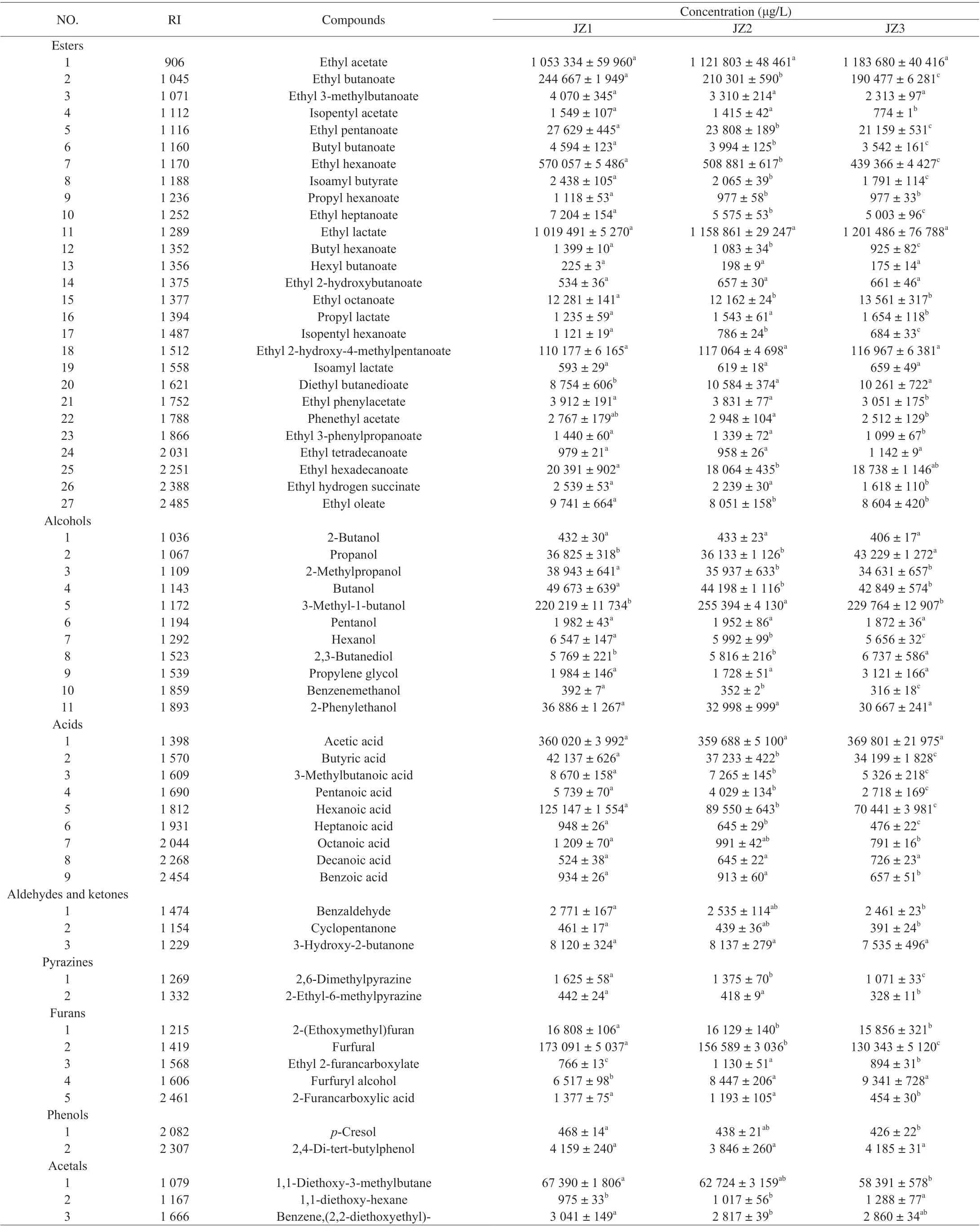
Table 2 Concentrations of aroma compounds by GC-MS in three different grades sesame-flavor Baijiu
4. Conclusion
A total of 61 aroma-active areas were identified in three different grades of sesame-flavor Baijiu. JZ1 as the premium-grade Baijiu had the highest aroma intensities and concentrations. Dimethyl trisulfide,butanoic acid, phenylacetaldehyde, nonanoic acid had the significant difference (P< 0.05) in three Baijiu samples base on aroma intenesities. 2-Furylmethanethiol, ethyl butanoate, ethyl pentanoate,ethyl hexanoate, hexanol, butyric acid, pentanoic acid, hexanoic acid,2,6-dimethylpyrazine, furfural, ethyl 2-furancarboxylate etc. had the significant difference (P< 0.05) based on concentrations. Therefore,the above compounds play an important role in distinguishing three different grades of sesame-flavor Baijiu. Sensory evaluation showed that JZ1 had an outstanding roasted aroma intensity than JZ2 and JZ3.2-Furylmethanethiol, 2,6-dimethylpyrazine were related to the roasted aroma, they may be had significant contributions to the differences of three different grades of sesame-flavor Baijiu.
A better understanding of the different grades of the sesame-flavor Baijiu can be helpful for improving their characteristic aroma and increase the yield of the premium-grade Baijiu products. Therefore,further research in this area will focus on the validation of the key aroma compounds, odorant precursors, and formation pathways in sesame-flavor Baijiu, so as to provide a theoretical basis for the regulation of the aroma and flavors of sesame-flavor Baijiu.
Declaration of competing interest
The authors declare that they have no competing interests.
Acknowledgement
This work was supported by the National Natural Science Foundation of China (32172340).
Appendix A. Supplementary data
Supplementary data associated with this article can be found, in the online version, at http://doi.org/10.1016/j.fshw.2022.07.025.
杂志排行
食品科学与人类健康(英文)的其它文章
- Evaluation and selection of yeasts as potential aroma enhancers for the production of dry-cured ham
- Preserved egg white alleviates DSS-induced colitis in mice through the reduction of oxidative stress, modulation of inf lammatory cytokines,NF-κB, MAPK and gut microbiota composition
- Energy status regulated umami compound metabolism in harvested shiitake mushrooms (Lentinus edodes) with spores triggered to release
- Edible mushrooms as a potent therapeutics of subclinical thyroid dysfunction among adults, especially in obese individuals: a prospective cohort study
- Screening hepatoprotective effective components of Lonicerae japonica Flos based on the spectrum-effect relationship and its mechanism exploring
- Effects of the degree of oral processing on the properties of saliva-participating emulsions: using stewed pork with brown sauce as the model
